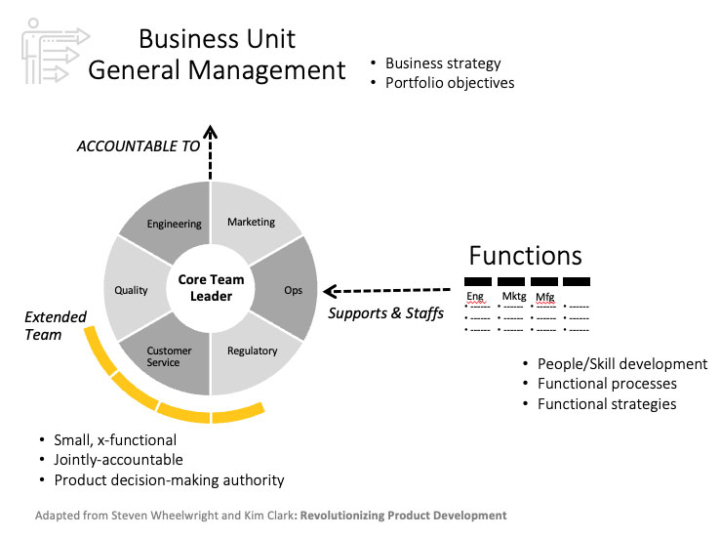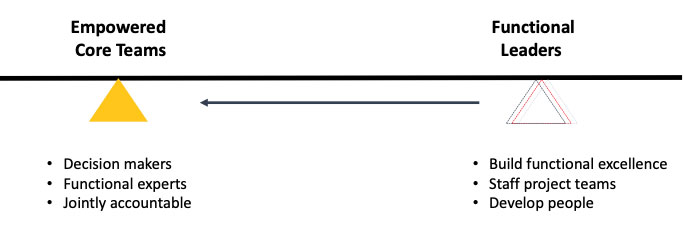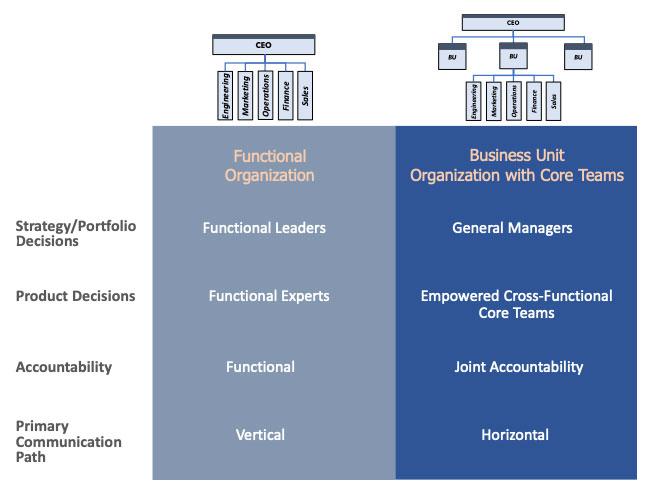Joel M. Podolny and Morten T. Hansen’s article in the December 2020 edition of the Harvard Business Review, “How Apple Is Organized for Innovation,” is a fascinating read. How can you not be seduced by the organization and product development approach of this century’s most successful company? The article describes Apple’s functional organization and how it is designed to enable a decision-making model of “experts leading experts”.
These experts are organized across 17 disciplines (e.g., design, hardware engineering, software, services, operations, finance, marketing, etc.) in a functional organizational structure with one company-wide P&L. The article uses the iPhone camera to explain how a series of continuous release technology and feature decisions were made by experts in camera technology, which led to it becoming a defining feature of the iPhone. The article goes on the say, “Relying on technical experts rather than general managers increases the odds that those bets will pay off.”
Apple’s approach counters prevailing wisdom where a general manager with P&L responsibility is charged with maximizing results for his or her individual business unit with full control over key functions. Podolny and Hansen make the point that general managers motivated by short term, companywide profit and cost targets would make sub-optimized product decisions. Instead, R&D functional leaders with a deep understanding of cost, technology, and user experience benefits make product cost trade-off decisions. Apple’s functional leaders are involved in very detailed product decisions. For example, the curved shape of the iPhone’s corners.
The Right Organization for Your Company
Apple has earned the right to be taken seriously. But is Apple’s functional structure right for your company? Are there elements of the “experts leading experts” approach you should consider? What if you could achieve the benefits of the functional structure while maintaining the advantages of your existing business unit structure?
Product Decision Making
Apple competes in markets where the pace of technology change is extremely high, so it stands to reason that technology expertise is highly valued when making product trade-off decisions.
The assumption the article’s authors make when comparing the functional structure to the business unit structure is that business unit general managers, without deep technical expertise, are required to make product technology and feature set trade-off decisions. This does not need to be the case. General managers in high performing hierarchical organizations empower small, cross-functional project Core Teams to make product technology and feature set decisions. These teams are staffed with functional experts that work with an extended team of technical specialists. The Core Team structure puts product decision-making responsibility in the hands of the development team, freeing up functional leaders to focus on building departmental excellence—people development, domain expertise, functional process development, and functional strategies. The business unit general manager stays out of day-to-day product decisions. He or she is ultimately responsible for the business unit P&L, setting strategy, establishing portfolio objectives, and making investment allocation decisions. This approach is illustrated in the graphic below:

One of the challenges of the functional structure, as the article repeatedly points out, is the heavy reliance on cross-functional collaboration. The Core Team structure is an effective way to achieve collaborative decision-making by breaking down the silos that are common in functional organizations. Decision-making and accountability move toward a project-centric model where development happens concurrently across functions, and success in the market is the primary measurement of project team members’ success. The functional leader’s role shifts from a project-level decision-maker to project supporter while pushing project-level decision-making to the ones closest to project issues as shown in the graphic below.

New product innovation requires project teams to make hundreds of decisions each week. Timely decision-making is critical. Nothing slows a project team down more than a team member who feels the need to go up the functional chain of command to get permission to make a decision.
Using the cross-functional Core Team approach, teams are staffed with empowered decision-makers who are jointly accountable for project success. The role is much more than that of a functional liaison or Project Coordinator. Core Team members have deep functional expertise, understand functional strategies, and know how best to apply them to project-level decisions.
Communication & Collaboration
Remarkably, Apple has maintained its functional structure despite experiencing exponential growth over the last 20 years. The article highlights some of the organizational and leadership challenges that have come with this growth, including communication within and across larger, increasingly specialized functions. There are hundreds of specialist teams that must come together to develop a product. Cross-functional stalemates are escalated to higher level managers who act as tiebreakers. Development can slow to a snail’s pace without effective collaboration among functional leaders. Functionally separate decision-makers must put their own agendas aside in favor of common project goals.
The article exposes system-level design as another challenge area for Apple. A functional approach may be well suited for technical subsystems or technologies (the iPhone camera, enclosure, or a software feature), but what is best for each subsystem may not be what is best for the product as a whole. A system-level view requires careful communication and collaboration across functions.
As organizations scale and become more complex, effective communication gets more difficult. Communication needs to take place across functional boundaries and up and down the corporate hierarchy. The more functionally siloed an organization is, the more tangled inter-functional communication becomes, as information must move horizontally across functions and vertically up and down leadership layers. The small, cross-functional Core Team structure short circuits this challenge by replicating the communication efficiencies of a small startup within a large organization.
In the following graphic, I have summarized the key differences between innovation in a functional organization and innovation in a business unit structure with cross-functional Core Teams.

Platforms
One of the keys to Apple’s success is their ability to continuously “wow” consumers with unique, easy-to-use product features. The article gives several examples of how functional leaders with technical knowledge work with a deep bench of specialists to perfect new-to-the-world technologies that can be leveraged across multiple product lines (iPhones, iPads, laptops, and desktops). Dispersing these specialists across multiple product lines in a business unit structure would dilute this capability.
Is there a way to achieve the same benefits of technology leverage in the business unit structure? Absolutely. The answer lies in platforms—by separating platform development from product line or individual product development, companies organized in a business unit structure can focus expert teams on new defining technologies that benefit multiple product lines. Platform teams are set up outside of the business units allowing them to focus and bring differentiating cost structure, capabilities, or technologies to next generation product lines in multiple business units.
Unlike product development, the goal of platform development is to create the critical elements that enable development of next generation products. This difference warrants different, bigger picture strategy, investment criteria, planning, and team organization outside of the business unit.
Podolny and Hansen have provided us with a captivating window into how Apple is organized for innovation. Its functional organization and “experts leading experts” approach has enabled unrivaled and lasting success. It is remarkable that this functional structure has stood the test of time despite the company’s exponential growth. We can learn a lot from Apple, but let’s pump the brakes before we consider wholesale changes to the multi-business unit structure. Many of the same benefits and more can be achieved with small, cross-functional product development and platform teams staffed with functional experts, empowered with decision-making authority, and structured for rich communication and collaboration across functions.
